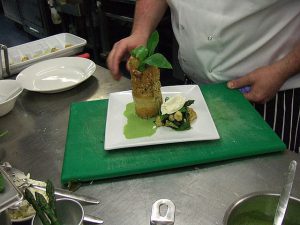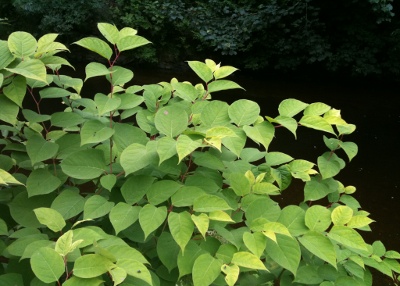Can you eat Japanese knotweed?
07-02-2018
Last updated 16-06-2022
 In late February and early March – when the worst of the winter is over and the weather’s started to warm – you may come across some young Japanese knotweed spears emerging and wonder “can you eat Japanese knotweed?”. Unlike giant hogweed, Japanese knotweed is not harmful to touch and you can eat it raw or cooked. There are many recipes available for eating young knotweed shoots, and it provides a source of vitamins A and C and the antioxidants rutin and resveratrol. However, care should be taken when foraging for or selecting the Japanese knotweed plants to eat. Should you wish to eat Japanese knotweed (and there are some recipe links, and examples of cooking with Japanese knotweed towards the end of this article) please be sure what it is you are eating. Once you know how to identify Japanese knotweed, and are sure it’s not one of the other plants mistaken for Japanese knotweed caution is advised to avoid plants that have previously been treated with pesticides or are growing on contaminated land. As repeated herbicide application is necessary to successfully control Japanese knotweed, it may not be possible to immediately recognise it if the plants have been treated in the past. So you must only eat Japanese knotweed when you are sure you are collecting plants from a site you know has not been subject to herbicide treatment or other contamination in the past. Japanese knotweed crumble (recipe below) or Japanese knotweed vodka may (or may not) sound delicious, but it is only when the young shoots are around 6-8 inches tall (usually in April and May) that they should be picked to eat. After that they become woody, bitter and difficult to digest. However, there are some traditional Japanese recipes that soften the mature stems by boiling for 20-30 minutes. The taste of Japanese knotweed has been described by the botanist and broadcaster James Wong as having a bright, tangy, aromatic flavour or being similar to a lemony rhubarb. Japanese knotweed can be used in cooking to create sweet or savoury dishes. The award winning Brighton restaurant Terre a Terre teamed up with Phlorum to cook Japanese knotweed with ginger, raspberries, sugar and vanilla, creating a compote served on oatcakes with Slipcote cheese. Should you be inspired to try or adapt Andy Hamilton’s vodka recipe (another botanical flavour to add to gin perhaps?) the phrase “please drink responsibly” takes on a whole new meaning as discarded Japanese knotweed is a controlled waste, so all the cuttings should be transported and disposed of carefully and in accordance with the law. Care should also be taken when harvesting the stems so as not to disturb the plants’ rhizome system as this could cause it to spread.
In late February and early March – when the worst of the winter is over and the weather’s started to warm – you may come across some young Japanese knotweed spears emerging and wonder “can you eat Japanese knotweed?”. Unlike giant hogweed, Japanese knotweed is not harmful to touch and you can eat it raw or cooked. There are many recipes available for eating young knotweed shoots, and it provides a source of vitamins A and C and the antioxidants rutin and resveratrol. However, care should be taken when foraging for or selecting the Japanese knotweed plants to eat. Should you wish to eat Japanese knotweed (and there are some recipe links, and examples of cooking with Japanese knotweed towards the end of this article) please be sure what it is you are eating. Once you know how to identify Japanese knotweed, and are sure it’s not one of the other plants mistaken for Japanese knotweed caution is advised to avoid plants that have previously been treated with pesticides or are growing on contaminated land. As repeated herbicide application is necessary to successfully control Japanese knotweed, it may not be possible to immediately recognise it if the plants have been treated in the past. So you must only eat Japanese knotweed when you are sure you are collecting plants from a site you know has not been subject to herbicide treatment or other contamination in the past. Japanese knotweed crumble (recipe below) or Japanese knotweed vodka may (or may not) sound delicious, but it is only when the young shoots are around 6-8 inches tall (usually in April and May) that they should be picked to eat. After that they become woody, bitter and difficult to digest. However, there are some traditional Japanese recipes that soften the mature stems by boiling for 20-30 minutes. The taste of Japanese knotweed has been described by the botanist and broadcaster James Wong as having a bright, tangy, aromatic flavour or being similar to a lemony rhubarb. Japanese knotweed can be used in cooking to create sweet or savoury dishes. The award winning Brighton restaurant Terre a Terre teamed up with Phlorum to cook Japanese knotweed with ginger, raspberries, sugar and vanilla, creating a compote served on oatcakes with Slipcote cheese. Should you be inspired to try or adapt Andy Hamilton’s vodka recipe (another botanical flavour to add to gin perhaps?) the phrase “please drink responsibly” takes on a whole new meaning as discarded Japanese knotweed is a controlled waste, so all the cuttings should be transported and disposed of carefully and in accordance with the law. Care should also be taken when harvesting the stems so as not to disturb the plants’ rhizome system as this could cause it to spread.



